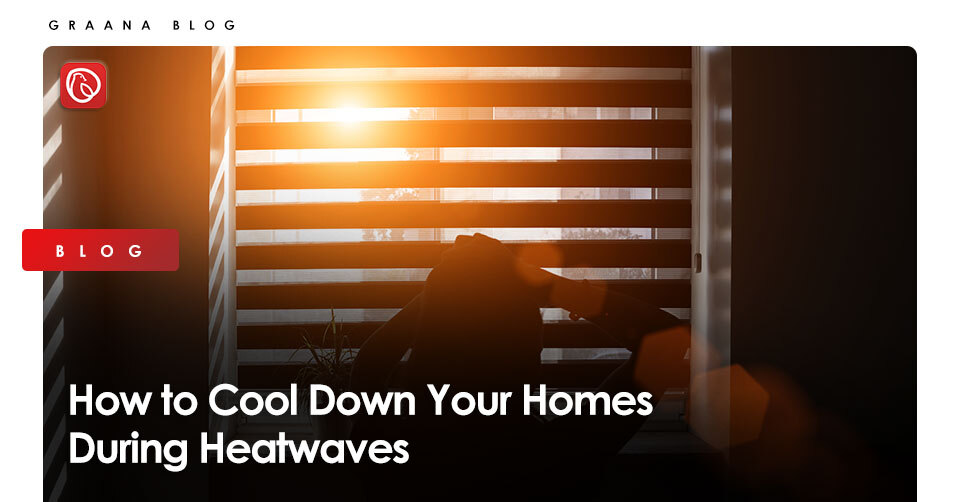
Heatwaves are prolonged periods of hot weather usually accompanied by high humidity. Over the past few years, there has been a significant increase in heatwaves due to global warming. Countries such as Pakistan and India have been most affected, with temperatures rising above 50 degrees Celsius in most parts.
Heatwaves are caused when hot air or radiations from the sun are trapped inside the atmosphere. In most parts of the world, population exposure to heatwaves is due to climate change. According to WHO, 125 million people were affected due to heatwaves from 2000 to 2016. The number has been much higher in recent years.
Heatwaves can cause serious health problems, and trigger water shortage issues and power breakouts. Additionally, there are chances of food shortages, as extreme heats affect crops and livestock. Therefore, it is essential to adopt certain preventive measures to cool down the surroundings.
Graana.com, Pakistan’s smartest property portal, presents a guide to cooling down your home during heatwaves.
The impact of heatwaves is mainly dependent on the duration and intensity of the hot weather. However, factors such as preparedness, infrastructure, and adaptation by the population also add to the overall impact.
Extreme sweating is one of the major problems caused by the heatwaves. It causes dehydration, which becomes a cause of several other health problems. The following are some health conditions caused due to heatwaves:
However, these symptoms or conditions may vary from person to person. To reduce the impact of heatwaves, certain measures are essential.
Urban heating is one of the major problems in cities. It is caused due to narrow areas and concrete buildings, which absorb heat and do not let it escape the atmosphere. The result is a rise in temperatures.
The roofs of buildings mostly absorb heat and radiation from the sun, which causes a rise in the temperature inside the building.
Let’s discuss the measures to reduce the impact of heatwaves:
During summers, the temperature rise inside the building is mostly due to the roof; it absorbs heat and pushes it down to the inside space, causing high humidity. A traditional roof absorbs more heat than a ‘cool roof’, which contributes to air conditioning and higher energy costs.
According to the Environmental Protection Agency, a roof’s capacity to reflect solar heat and release absorbed heat (emissivity) determines the effectiveness of roofs during extremely hot weather. Therefore, the first step to cooling down homes during heatwaves is to reduce heat on roofs.
The following strategies can enhance this capability:
It is important to use a proper ventilation system during summers as it will allow the heat to pass out from the building. Therefore, keeping windows open and curtain and blinds shut can help a great deal.
This will ensure lesser chances of rising temperatures inside the building and their effects, like dry skin and respiratory problems.
Keeping blinds and curtains shut, however, is not enough to prevent the impact of hot air. It is essential to keep the interior cool as well. Using a centralised air-cooling system inside the building can help circulate cool air equally in various parts of the building and keep the temperature in control.
Installing a centralised air-cooling system might be a more costly option, but it will eventually help you survive the harsh summer conditions.
Most people are unaware of the heating effect caused by electronic appliances at home. Devices such as refrigerators, ovens, electric stoves, and computers release heat and radiation, which increase temperatures inside the building. Therefore, it is necessary to switch off these devices when they are not in use.
One of the most important strategies that can be adapted to cool down the temperature inside the building is to cool down the surrounding. In urban areas, there are fewer plants and gardens, which is why they are hotter than in rural areas. Therefore, growing plants and vegetation can help lower the temperature of the surroundings.
Plants reduce the surface area exposed directly to the sunlight and, consequently, reduce surrounding temperatures. Moreover, they help to cool down the environment through evaporation and transpiration.
Rooftop gardens are modern ways to reduce external heat. Another technique is to grow plants and vines on the walls. Vines cover the walls and help reduce the temperature.
All these measures can help a great deal to cool down the building during extreme heatwaves.
Apart from the above external measures, measures for personal protection are also essential, such as the following:
Just like humans, birds also suffer from the scorching heat. Most cannot find shelters and water or food resources to save themselves. Therefore, it is also essential to take the following measures to save birds from extreme conditions:
Most birds are unable to find new, cooler spots to build nests during heatwaves. Therefore, building shelters in places of shades can help them survive these harsh conditions. These should be easily accessible to migrating or displaced birds.
Hot conditions cause water in reservoirs to evaporate, leaving birds with no drinking water. Moreover, due to effects on crops and livestock, there is food depletion.. So, to help them survive these harsh conditions, food and water sources should be kept outside and refilled regularly.
For more information about heatwaves and preventive measures, visit Graana Blog.
Open Glass Façade Buildings: Types, Construction & More
The 19th Real Estate Development Summit Saudi Arabia – Luxury Edition concluded after two days…
Islamabad: The Shaheen Chowk underpass is expected to be inaugurated next week after nearing completion,…
Dubai’s luxury real estate market has reached a new milestone in 2025, with a prime…
Karachi: Sindh Chief Minister Syed Murad Ali Shah has approved a development package worth PKR…
Islamabad: The Capital Development Authority raised PKR 13.52 billion on the opening day of its…
Riyadh: Saudi Arabia will allow foreigners to own property in the Kingdom starting in 2026…